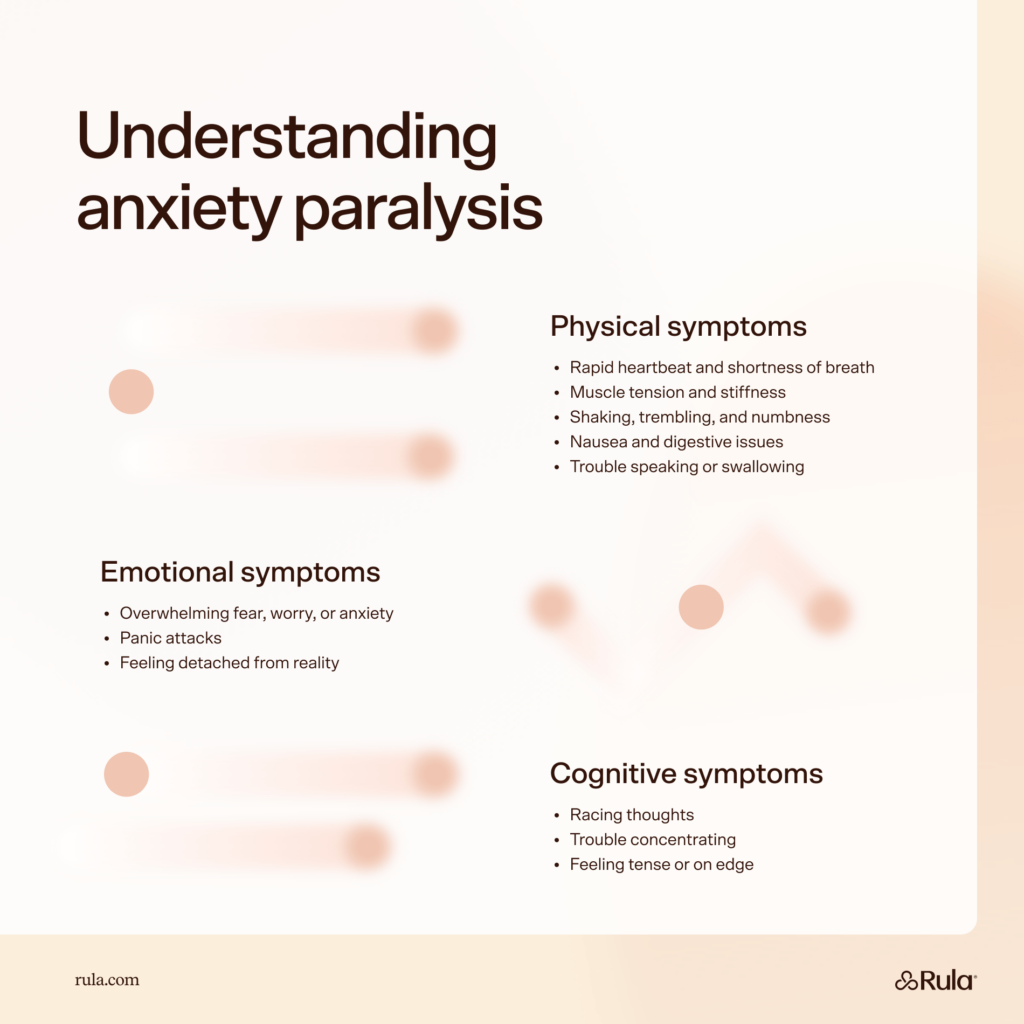Key Takeaways
Anxiety paralysis happens when anxiety becomes so overwhelming that it temporarily shuts down your ability to act.
Although anxiety is considered a normal reaction to stress, anxiety paralysis is an extreme response that makes it difficult to speak, move, or think.
Talk therapy, medication management, and mind-body techniques can all help people to manage symptoms and overcome anxiety paralysis.
Anxiety paralysis happens when anxiety becomes so intense that it temporarily prevents you from being able to act. Anxiety is a normal stress response, but when it becomes intense, it can cause a “freeze” reaction — making it hard to move, speak, or even think. While feeling anxious from time to time is common, anxiety paralysis is more likely to affect people with anxiety disorders.

What is anxiety paralysis?
Anyone who experiences an anxiety disorder knows that it can be difficult. Moments of panic or dread can creep up unexpectedly and are often accompanied by a slew of physiological symptoms, like excessive sweating, racing heartbeat, and trembling hands. For some people, it’s so overwhelming they actually feel temporarily paralyzed by their anxiety.
Anxiety paralysis is a full-body experience that creates the feeling of being frozen or stuck. With anxiety paralysis, it can be difficult to speak, move your body, or even process what’s happening around you.
Signs of anxiety paralysis
Anxiety paralysis can affect your body, emotions, and thoughts all at once. This can make it hard to function in daily life. Below are some common physical, emotional, and cognitive signs to watch for.
Physical symptoms
Rapid heartbeat and shortness of breath
Muscle tension and stiffness
Shaking, trembling, and numbness
Nausea and digestive issues
Trouble speaking or swallowing
Emotional symptoms
Cognitive symptoms
Racing thoughts
Trouble concentrating
Feeling tense or on edge
Anxiety paralysis symptoms can have a significant effect on how people live their lives. For example, it can cause someone to avoid triggering situations or environments, potentially leading to loneliness or isolation. Anxiety paralysis can also interfere with people’s ability to concentrate, causing performance issues at work or school.
The link between anxiety and paralysis
Knowing all this, you might still be wondering why exactly anxiety leads to paralysis. The answer relates to the nervous system. When a person faces a perceived threat, their body triggers a response to help protect them, such as fight, flight, or freeze.
The reaction begins in the amygdala, the part of the brain responsible for fear, and then moves to the hypothalamus, triggering the autonomic nervous system. From there, the sympathetic system stimulates the adrenal glands which release stress hormones, like adrenaline and cortisol. For someone living with anxiety, this process can even happen during periods of normal, everyday stress.
When people feel threatened, both the sympathetic and parasympathetic branches of the nervous system are triggered to support them through periods of danger. While the fight and flight responses have sympathetic dominance, the freeze response has parasympathetic dominance.
The parasympathetic nervous system is responsible for the body’s relaxation response. When we experience a freeze reaction to fear, parasympathetic dominance is responsible for slowed heart rate, increased muscle tone, and absence of movement, and can contribute to that feeling of being paralyzed with anxiety.
Causes of anxiety paralysis
There’s no one set reason why people develop anxiety, but potential causes include stress, trauma, and genetics.
1. Stress
One potential cause of anxiety is stress. Stress is the body’s response to external threats and anxiety is the body’s response to that stress. When a person experiences too much stress, it may contribute to the development of an anxiety disorder.
Specific anxiety traits may also play a role, according to one study. The findings suggest that social anxiety and the impact of physical symptoms of anxiety may be predictive of something called tonic immobility, a temporary state of inactivity that occurs as a response to fear. The data also suggest that freeze was more highly associated with certain cognitive symptoms of anxiety, like confusion and detached concentration.
2. Past trauma
Trauma is an emotional response to experiencing or witnessing distressing life events, like an accident, physical violence, or sexual assault. Approximately 70% of U.S. adults experience some type of traumatic event at least once in their lives, and for some people it can lead to symptoms of anxiety. In fact, recent research concluded that childhood trauma may be a risk factor for developing anxiety later in life.
3. Genetics
Data point to genetics as another potential cause of anxiety paralysis. Anxiety disorders can be inherited so having a family history of anxiety may mean that you’re more likely to develop anxiety symptoms yourself. It’s also worth noting that anxiety disorders occur more frequently in women than in men.
Four coping strategies for anxiety paralysis
If you’re wondering how to manage anxiety paralysis, the good news is that it can improve with the right support. Here are four effective strategies that may help you cope and regain a sense of control.
1. Talk therapy
If you think you might be experiencing anxiety, consider working with a mental health professional to better understand your condition. Therapists use a wide range of tools to help people effectively manage anxiety paralysis and other anxiety symptoms.
One example is cognitive behavioral therapy (CBT), a type of talk therapy that focuses on identifying and changing negative thought patterns and behaviors. By increasing self-awareness, CBT can help people identify the thoughts and behaviors that are contributing to their paralysis and develop healthier ways to cope with those emotions.
2. Grounding exercises
Mind-body practices like mindfulness and meditation are valuable tools for improving focus and reducing stress. In fact, recent research suggests that mindfulness-based interventions may be just as effective as CBT for improving anxiety levels and reducing anxiety symptoms.
Here are a few examples of grounding exercises to practice at home.
Deep breathing: Find a quiet, comfortable space to sit and close your eyes. Take a few deep breaths and focus on the sensation of the breath entering and leaving your body (the fall of your chest or the breath in your nostrils). You may become distracted, but allow yourself to focus on your breath without any judgment.
Progressive muscle relaxation: This practice helps promote relaxation, reduce stress, and release physical tension. Find a quiet area and take a few deep breaths to center yourself. Tense the muscles in your toes for 5–10 seconds, then relax for 15–30 seconds. Continue with each muscle group, slowly working up to your face.
The 5–4–3–2–1 technique: Try to name five things you can see, four things you can feel, three things you can hear, two things you can smell, and one thing you can taste.
Dig deeper:
3. Breaking things down into steps
When tasks feel overwhelming, try breaking them into smaller, more manageable steps. Focus on completing just one small task at a time instead of the entire project. This can make things feel less intimidating and help build momentum.
4. Medication
Anxiety therapy, mindfulness techniques, and lifestyle changes aren’t always enough to effectively manage a person’s anxiety paralysis. If this is true for you, consider speaking with a psychiatric provider about adding medication management to your treatment plan.
Clinician's take
When anxiety leaves you frozen, even the smallest step forward matters. Progress isn’t about moving fast — it’s about proving to yourself that you can move at all.

Brandy Chalmers, LPC
Clinical reviewer
Overcome anxiety paralysis with help from Rula
When left untreated, anxiety paralysis can have a debilitating effect on people’s lives. The good news is that it can be effectively managed with professional support, mind-body strategies, and medication management.
If you or someone you know is living with anxiety, speaking with a mental health professional can help. Rula’s diverse network of providers includes more than 15,000 licensed therapists practicing over 100 modalities, including cognitive behavioral therapy (CBT). Using Rula, you can easily find a therapist who understands anxiety paralysis, is taking new clients, and accepts your insurance. Plus, Rula’s platform is designed to make it easy to attend sessions virtually from the comfort of your home.
Find therapists who specialize in Anxiety near you
New York – Texas – California – Georgia – Illinois – Hawaii – Indiana – Virginia – North Carolina – Pennsylvania – Find your location